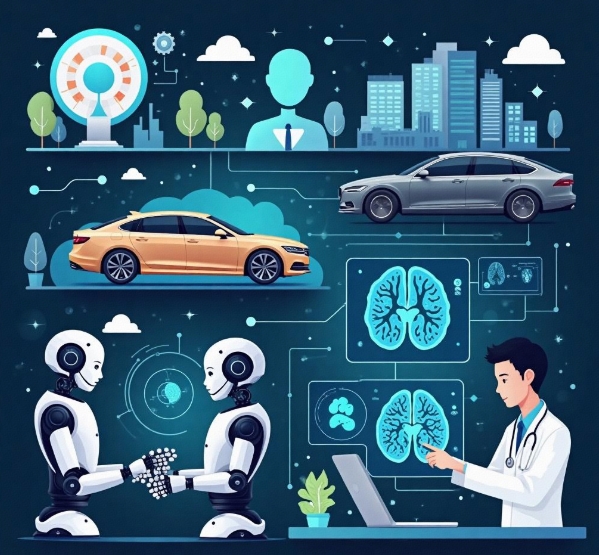Core Technologies of Artificial Intelligence: Machine Learning and Deep Learning
- latest articles
- 1.DApp Development & Customization: Merging Diverse Market Needs with User Experience 2.Analysis of the Core Technical System in DApp Project Development 3.How to achieve cross-chain interoperability in Web3 projects? 4.How does the tokenization of points reconstruct the e-commerce ecosystem? 5.How to Set and Track Data Metrics for a Points Mall? 6.What is DApp Development? Core Concepts and Technical Analysis 7.Inventory of commonly used Web3 development tools and usage tips 8.Development of a Distribution System Integrated with Social E-commerce 9.Six Key Steps for Businesses to Build a Points Mall System 10.What is DApp Development? A Comprehensive Guide from Concept to Implementation
- Popular Articles
- 1.Future Trends and Technology Predictions for APP Development in 2025 2.Analysis of the DeFi Ecosystem: How Developers Can Participate in Decentralized Finance Innovation 3.From Zero to One: How PI Mall Revolutionizes the Traditional E-commerce Model 4.DAPP Development | Best Practices for Professional Customization and Rapid Launch 5.Recommended by the Web3 developer community: the most noteworthy forums and resources 6.From Cloud Computing to Computing Power Leasing: Building a Flexible and Scalable Computing Resource Platform 7.How to Develop a Successful Douyin Mini Program: Technical Architecture and Best Practices 8.Shared Bike System APP: The Convenient Choice in the Era of Smart Travel 9.How to Create a Successful Dating App: From Needs Analysis to User Experience Design 10.From Design to Development: The Complete Process of Bringing an APP Idea to Life
With the rapid advancement of technology, artificial intelligence (AI) has become one of the most prominent research directions in the tech field today. Whether it's voice assistants, autonomous driving, image recognition, or intelligent recommendations, AI technology has permeated almost every aspect of our daily lives. In this vast field, machine learning (Machine Learning, ML) and deep learning (Deep Learning, DL) are considered the core technologies that constitute modern artificial intelligence. They not only drive the rapid development of AI but also lead numerous technological breakthroughs.
Core Concepts of Machine Learning
Machine learning is a technology that enables computers to automatically learn from data and make predictions or decisions. Unlike traditional programming, in machine learning, computers do not complete tasks through explicit rules and instructions but instead learn from large amounts of historical data to discover patterns and regularities on their own.
1.1 Classification of Machine Learning
Machine learning is typically divided into three types: supervised learning, unsupervised learning, and reinforcement learning.
Supervised Learning (Supervised Learning): In supervised learning, the training data includes labeled input and output information. The algorithm learns the patterns in the data to establish a mapping relationship from input to output. Classic applications include image classification, speech recognition, and stock prediction.
Unsupervised Learning (Unsupervised Learning): Unlike supervised learning, unsupervised learning does not have labeled data. The algorithm needs to discover the underlying structure or patterns in the data on its own. For example, clustering algorithms and dimensionality reduction techniques (such as PCA) are typical unsupervised learning methods.
Reinforcement Learning (Reinforcement Learning): Reinforcement learning differs from the other two methods as it focuses more on obtaining maximum rewards through interaction with the environment. A classic application of reinforcement learning is in the gaming field, such as AlphaGo, which is a typical case of reinforcement learning.
1.2 Key Technologies in Machine Learning
The success of machine learning relies not only on algorithm design but also on large amounts of data and computational power. With the support of big data and cloud computing technologies, machine learning has developed rapidly. The following are several key technologies:
Feature Engineering: In machine learning, features are various attributes used to describe data. Feature engineering refers to the technical means of extracting meaningful features from raw data to improve model accuracy.
Model Selection and Evaluation: Different types of machine learning tasks require selecting different algorithm models, such as decision trees, support vector machines (SVM), and neural networks. At the same time, model evaluation metrics (such as accuracy, precision, recall, etc.) are also crucial.
Overfitting and Underfitting: These are very important concepts in machine learning. Overfitting refers to the model being too closely fitted to the training data, resulting in poor predictive ability for new data; underfitting, on the other hand, means the model is too simple to capture the inherent patterns in the data.
The Rise of Deep Learning
With the improvement in computational power and the increase in data volume, deep learning, as a branch of machine learning, has made remarkable progress in recent years. The basic idea of deep learning is to simulate the connection structure of neurons in the human brain through multi-layer neural networks, thereby automatically extracting features from data.
2.1 Fundamentals of Neural Networks
Neural networks are inspired by the neuron model in biology. The simplest neural network consists of an input layer, hidden layers, and an output layer. Each layer is composed of several neurons, and these neurons are connected through weighted links for information transmission. The training process of a neural network involves adjusting the weights of these connections through the backpropagation algorithm so that the network's output is as close as possible to the true value.
2.2 Breakthroughs in Deep Learning
The "depth" in deep learning refers to the number of hidden layers in the network. Traditional shallow neural networks (such as perceptrons) can often only handle simple tasks, while deep neural networks (DNNs) can extract higher-level features from complex data through multiple layers of nonlinear transformations. As a result, deep learning has achieved significant results in fields such as image recognition and natural language processing.
Convolutional Neural Networks (CNN): CNNs are an important application of deep learning in the field of computer vision, especially in image recognition and processing. By combining convolutional layers, pooling layers, and fully connected layers, CNNs effectively extract local features from images to accomplish tasks such as object classification and facial recognition.
Recurrent Neural Networks (RNN): RNNs are mainly used to process sequential data, such as speech, text, and time series analysis. Unlike traditional neural networks, RNNs have "memory" capabilities and can handle and predict temporal dependencies in sequences through recurrent connections.
Generative Adversarial Networks (GAN): GANs generate realistic images, audio, and other data through the adversarial process between a generator and a discriminator. They have achieved excellent results in fields such as image generation and style transfer.
2.3 Technical Challenges in Deep Learning
Although deep learning has made breakthroughs in many fields, it still faces some challenges. First, deep learning models require large amounts of labeled data and powerful computational resources. Second, the interpretability of deep learning models is poor, which poses certain risks when applied in fields such as healthcare and finance. Additionally, the training process of deep learning is often a "black box," leading to lower understanding and trust in the results.
Integration and Future Development of Machine Learning and Deep Learning
Although machine learning and deep learning have many technical differences, they are not mutually exclusive. In fact, deep learning is an important branch of machine learning, and its development has greatly advanced artificial intelligence technology. As technology continues to evolve, the integration of machine learning and deep learning will become a trend in future development.
3.1 Self-Supervised Learning: A New Direction for the Future
Self-supervised learning is an emerging machine learning method that does not require manually labeled training data but instead uses the data itself for supervision. In this way, machines can learn effective features from large amounts of unlabeled data and apply them to various tasks. Self-supervised learning has made significant progress in natural language processing (such as the GPT series of models) and computer vision (such as BERT, SimCLR, etc.), and it is expected to become an important direction in the field of machine learning in the future.
3.2 Federated Learning: A New Model for Distributed Learning
Federated learning is a distributed machine learning method that allows data to remain on local devices rather than being centralized in the cloud for training. This not only addresses issues of data privacy and security but also significantly reduces computational costs. Federated learning has already been applied in fields such as mobile devices, smart homes, and healthcare. With the widespread adoption of 5G technology, the application scenarios for federated learning will become even broader in the future.
3.3 Quantum Machine Learning: Breaking Through the Bottlenecks of Traditional Computing
Quantum computing, as an emerging computing paradigm, has the potential to transform the entire field of machine learning in the future. Quantum machine learning (QML) leverages the parallel processing capabilities of quantum computing to solve certain problems more efficiently than traditional computers. Although quantum computing is still in its early stages, with the continuous advancement of quantum hardware, QML is expected to bring revolutionary breakthroughs in big data processing, optimization problems, and machine learning algorithms.
Conclusion
As core technologies of artificial intelligence, machine learning and deep learning have achieved great success in many fields. They not only bring us more efficient intelligent applications but also drive profound changes in technology and industry. However, as technology continues to advance, machine learning and deep learning still face many challenges and unsolved mysteries. In the future, with the development of emerging technologies such as self-supervised learning, federated learning, and quantum machine learning, artificial intelligence will enter an era of greater intelligence and personalization, bringing even more profound impacts.
By continuously promoting research and innovation in machine learning and deep learning, we have reason to believe that artificial intelligence will continue to shape the future of society, economy, and culture, becoming an important tool for humanity to explore the unknown.
-

How does artificial intelligence technology transform the operational models of modern enterprises?
In the wave of the digital era, artificial intelligence (AI) technology has tran···
-

How to Utilize Artificial Intelligence for Precision Medicine and Health Management
With the rapid advancement of technology, artificial intelligence (AI) has demon···
-

Integration and Application of Artificial Intelligence and Robotics
In today's era of rapid technological advancement, the integration of artificial···

 Blockchain
Blockchain












